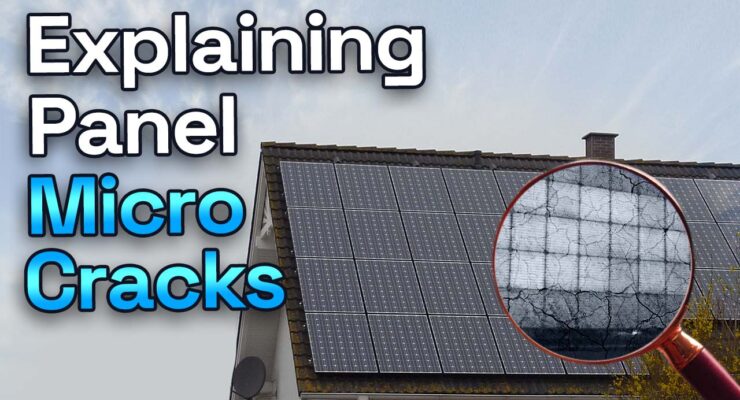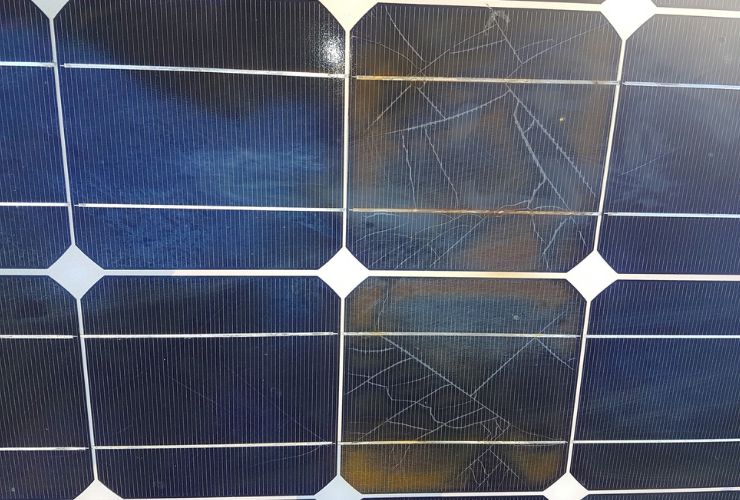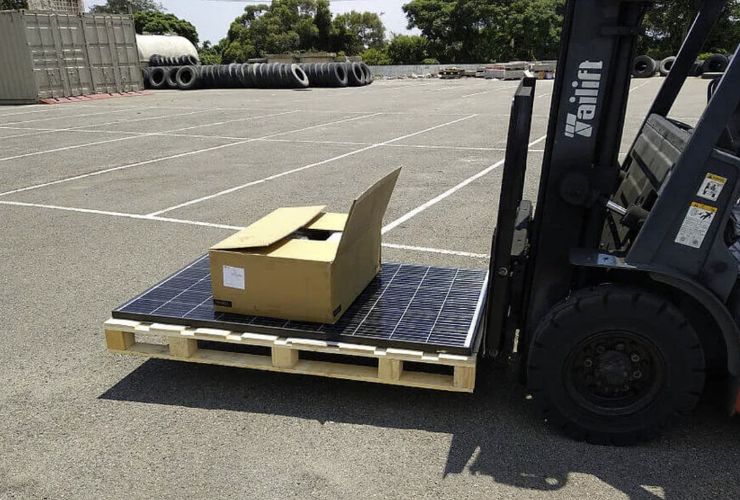
Fast read
Small fractures or cracks, commonly referred to as microcracks, can appear on the surface of solar panels.
These minute fractures, which can be brought on by mechanical stress, impact and abrupt temperature fluctuations, can decrease the effectiveness and durability of solar panels.
The amount of electricity that the panels can generate may be reduced by microcracks. Unfortunately, such cracks are more common in cheap solar panels.
Caring for trees near solar panels, purchasing high-quality panels, and ensuring proper installation can prevent small cracks in the panels. Taking care of trees near solar panels is important. Buying good quality panels is also crucial. Having them installed properly is essential.
Are microcracks in solar panels a serious issue?
Microcracks are tiny fractures or cracks that can appear on the surface of solar cells of the solar panel, as seen in the image below.
The performance of the solar panels may be adversely affected by these cracks over time, which are frequently quite minute and often cannot be seen by the naked eye.
Several reasons for microcracks in solar PV modules include poor quality control in the factory or mechanical stress caused by poor handling during distribution warehouse stacking, transport, or installation.
For example, stacking pallets with solar panels too high in a warehouse means the bottom pallet with panels might experience extreme weight, leading to microcracks in cells. Poor transport practices can also be an issue, especially when a pallet has moved and puts a lot of weight on one spot of the pallet underneath, as shown in the photo below.

After installation, the panels’ cells may develop microscopic cracks because of mechanical stress from wind or an impact such as a tree branch striking the panel or hail.
Why are microcracks bad for solar panels?
These tiny fractures can reduce the ability of solar panels to generate energy, as they can impede the electron flow.
The cracks across the cells prevent the movement of electrons over the crack, stopping the flow of electricity.
This restriction in electricity flow generates heat as the electricity has nowhere to go and over time causes further heat damage to the cells and will result in a runaway effect, leading to a worse and worse resistance in the specific cracked area of the cell.
The result will be that the cell in this area will become so hot from all the unreleased electrons that the panel will get “hotspots”, which will crack the glass over time, and the panel will be irreparably damaged.
What can cause microcracks?
Poor quality control in the manufacturing process, especially in cheap solar panel factories, can result in microcracks in the solar cells before the panels even leave the factory.
Quality solar panel manufacturers ensure minimal microcracks during production and prevent cells with visible cracks from being included in the panel. These microcracks become noticeable only when exposed to sunlight, expanding because of the heat and humidity during operation.
These more expensive panel manufacturers include EL imaging tests on panels in production to identify microcracks and repair such panels by swapping the cracked cells before leaving the factory.

Hail – the mother of many microcracks
While a small microcrack in the corner of one cell in a panel is unlikely to cause fatal hotspots, the situation escalates when multiple microcracks affect the panel.
This scenario often arises after a severe hailstorm. If the hailstorm causes panels to shatter, home and content insurance covers the replacement without issue.
However, if the hail impact doesn’t shatter the glass but damages the cell underneath, leading to numerous microcracks, homeowners may remain unaware of the compromised solar power system output. Over time, this situation might worsen, developing hotspots. Subsequently, warranty claims might be rejected if manufacturers identify the typical bullseye shatter pattern of hailstone impact during EL tests.
Hence, it’s advisable to inform your home and business insurance company if your PV system faces hail damage. This way, they can note it down in case hail-related hotspots surface on the panels in the future.

How to minimise microcracks?
Invest in high-quality solar panels
Quality Solar panel manufacturers have an extensive quality control and production maintenance program to minimise the risk of microcracks.
This includes EL and infra-red imaging of solar panels to detect even the smallest microcracks and cell imperfections and remove those cells and panels from the supply.
This can help lower the possibility of microcracks appearing on your panels and ensure that they continue to function at their peak for many years to come.
Regularly clean and maintain your panels
You can prevent microcracks from forming on your panels by trimming nearby trees back. The branches and limbs of nearby trees, dislodged during a storm, can hit PV panels, which will likely cause microcracks at the impact zone.
Avoid putting excessive stress on your panels.
Refraining from placing weight on the solar panels after installation is critical. For example, if installed on a flat roof, do not walk on the panels for any reason. If you or a panel cleaner decide to wash the panels, please do not use a high-pressure washer like a Kaercher.
Have your panels regularly inspected
Routine expert inspections can find microcracks and other possible panel problems. For example, while the naked eye cannot see many hairline microcracks in the silicon cells, there are ways via thermal imaging to identify hot spots in the panels before they cause burn marks and, therefore, fire risk in the panels.

How can I be sure I can see none after a hail storm if my panels have microcracks?
Electroluminescence (EL) testing can reveal cracks. EL testing means the panel in a testing lab, such as the PV lab in Canberra, is illuminated with a light source while an electrical bias is applied. The result of this photo shoot will show any cell defects, especially microcracks in solar panels.
How to deal with microcracks in solar panels
Often it is tough to pinpoint the cause of these microcracks. Like a murder mystery with many suspects.
- Did the panels leave the factory already with this issue?
- Did the container on the sea undergo a turbulent time?
- Did the distributor drop the pallet with the panels?
- Did the transport company not tie down the pallets appropriately, and they bounced to the installer’s warehouse?
- Did the installer just stash the panels in a trailer, and they jumped about on their way to you?
- Did the installer’s apprentice carry the panels roughly up the roof?
- Did a part of the neighbour’s tree branch hit our panel during the recent storm?
- When did we have our last local hailstorm?
So as you can see, making a manufacturer’s warranty claim because of microcracks is not as easy as it first seems.
We recommend the following steps
- Have your solar system inspected every 2-3 years;
- Ask the inspector to give attention to spotting microcracks;
- If no crack is found – great news, you have just eliminated the eight potential reasons as outlined above;
- If microcracks are found, record the damage via photos or video;
- Then contact your original installer to let them know (if they were not the solar company undertaking the inspection). Ask them if they believe the issue constitutes a warranty claim and if they can help you with such a claim;
- Observe the solar panel system output and see if the output is within the expected range. Our solar energy system output calculator can work out the desired range.
- If the output is okay – inform the manufacturer of the issue in writing and reserve your right to claim the track.
- If the output is below expected performance, consider making a warranty claim with the manufacturer- but it might not be easy to prove.
In summary
Microcracks in solar panels are bad because they can cause a reduction in efficiency and performance, leading to a decrease in energy production.
The severity of the microcrack determines the degree of impact on performance, but even small microcracks can cause a noticeable reduction in output. Over time, the effects of microcracks in solar panels can accumulate and lead to a shorter lifespan for the solar panel with cracks.


